.

The T20 format is all about exhilarating fast-paced cricket with a strong emphasis on hard-hitting and quick scoring. First introduced in the early 2000s, T20 cricket is not everyone's batsman's cup of tea: adapting to conditions and the nature of the pitch and score big from the outset. Scoring at six runs an over in T20 cricket is considered an underwhelming return.
But if we look back at the 90s, anything over six runs an over was a challenge. Batsmen were seldom creative with their strokeplay, the boundaries used to be bigger, and the pitches were generally tougher to bat on. It was the era before the advent of T20 cricket.
Could any batsman from that era finish a T20 innings with a flourish like an Andre Russell or a Glenn Maxwell? Possibly, yes.
On that note, let us look at ten such players from the pre-T20 era who would have relished the opportunity to play the shortest format of the game.
Ten pre-T20 era players who would have excelled in the shortest format of the game:
#10: Inzamam-ul-Haq
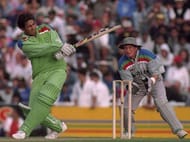
Inzamam-ul-Haq walked out to bat for only the 16th time in his career when he joined Javed Miandad at the crease in the semifinal of the 1992 World Cup. He scored a 37-ball-62 with seven fours and a six before he was run out. But by then Inzamam had done enough for Javed Miandad to help Pakistan over the line.
He also made a vital contribution in the World Cup final where he scored a 35-ball-42 after Pakistan had made a stuttering start.
Among his other notable contributions in the shorter format of the game was his unbeaten 90 that guided Pakistan to their first-ever ODI win in the Caribbean in nine matches.
The Multan-based batsman is the only one from his country to score over 20,000 runs in international cricket. Batting in the middle order, Inzamam averaged over 40 with the bat and scored at a rate of over 75, playing 252 combined innings at numbers four and five.
Inzamam was a fabulous batsman in the shorter format of the game. However, his running between the wickets could have hindered him in T20 cricket, but he could have more than made up for that with his significant hitting prowess.
#9: Imran Khan
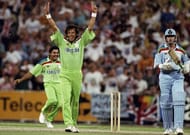
While Javed Miandad was outspoken, fiery and not close to being a likeable character even in Pakistan let alone in India, Imran Khan was loved by one and all. The cult status of the long-haired Pakistani captain surpassed borders and was almost unmatched by anyone in his generation.
Khan was looked up to by young men both on and off the field. His long hair was a trend in popular culture. For all the allure that Khan had off the pitch, he was an excellent all-rounder on the cricket field, leading Pakistan impressively during their 1992 World Cup campaign.
The only ODI century Khan scored came while batting at #5 in a game against Sri Lanka in the 1983 World Cup in Leeds. Pakistan were reduced to 43/5, but Imran Khan carried his bat through the innings, scoring an unbeaten century.
Khan's strike rate comfortably eclipses 75 from both #5 and #6 in over 80 cumulative innings that he played in these batting positions. One of his hard-hitting knocks was a 9-ball-25 back in 1986 in Sharjah against the much-touted West Indies' bowling attack. Well, Imran Khan could have also lit up a T20 game with his batting prowess.
What if he walked out to the crease at the Wankhede in the present-day? It definitely won't be a dreary spectacle.
#8: Kapil Dev
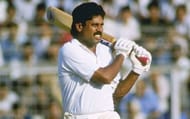
Incredulous! That is the only word to describe Kapil Dev's strike rate numbers from back in the day. His career strike rate touched a sky-high 95 in ODIs, but it skyrocketed to 106.9 in 35 innings from the #5 position.
In March 1983 in Guyana, Kapil Dev scored a 38-ball-72 in an innings that comprised seven fours and three sixes. While this was in the run-in to the World Cup, one of his most iconic knocks came in the World Cup itself.
With India reduced to 17-5 and then 76-7 by tournament debutants Zimbabwe, a huge upset was in the offing. But Kapil Dev weathered the storm and counter-attacked with gusto. Scoring a brilliant unbeaten 175* off 138 balls, he took India to a decent total of 266. His innings that comprised of 16 fours and six sixes remains one of the most iconic World Cup knocks during the tournament's 45-year history.
That innings alone is enough to argue a case for Kapil Dev being a solid fit in the T20 format.
#7: Javed Miandad
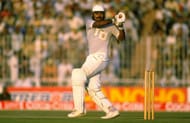
Javed Miandad batted predominantly at #4 in the batting order for Pakistan during his ODI career. While his strike rate of 69 wasn't an alluring number, nothing much can be argued about his grit that guided Pakistan over the line on numerous occasions.
Miandad, who scored 41 half-centuries in ODIs, remained not-out 29 times while batting at #4. In an ODI against India in Sharjah in 1986, with Pakistan needing a six off the final ball, Miandad smoked Chetan Sharma's over the square-leg boundary- a near inimitable feat even in the modern-day.
Fast forward six years, Miandad anchored Pakistan's run chase after they were reeling at 140/4 in a World Cup game after losing the dangerous Saleem Malik.
The character of Miandad - fiery and outspoken, someone who loved to get under the skin of opponents, would have made him a great fit in T20 cricket too. And who wouldn't love a last-ball six to pull off wins in the shortest format of the game?
#6: Chris Cairns
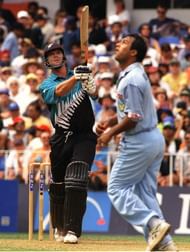
On 1st January 2014, Corey Anderson shattered the record for the fastest ODI century by blasting 100 runs of a mere 36 balls. The record for the previous fastest ODI century by a Kiwi batsman had belonged to a certain Chris Cairns.
In a Test Match at the Basin Reserve in 2000, Australia had reduced New Zealand to 66/5, of with the duo of Brett Lee and Shane Warne taking two wickets apiece. Chris Cairns walked out to join Nathan Astle at the crease and then went on a rampage.
Glenn McGrath was smashed for a couple of boundaries. However, the man who suffered most at the hands of Chris Cairns that day was Shane Warne. The leggie was smashed out of the attack by Cairns who brutally dispatched him for two sixes in his very first over.
Cairns followed a similar sort of approach in the limited-overs format. In ODIs, he batted in every batting position except 10 and 11. At every position, his strike rate was more than 80 and reached a maximum of 97 while batting at #7. Also, Cairns was a fast-medium bowler who scalped over 200 batsmen in both Tests, and ODIs.
He was a player who could have walked into any T20 team owing to his all-round prowess.
#5: Saleem Malik
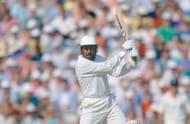
Towards the twilight of his nearly two-decade-long career, Saleem Malik had his reputation tainted after a life-ban was imposed on him for alleged match-fixing. Although the ban was lifted by a court in Lahore in 2008, Malik ended his career in disgrace and as a forgotten figure in the game.
That should not distract us from the batting capabilities of Saleem Malik. In an ODI at the Eden Gardens in 1987, Pakistan were down to 161/5 when Malik arrived at the crease while chasing 239 for victory in a rain-hit game that was reduced to 40 overs. Imran Khan was dismissed cheaply too, and that left Malik in the company of tail-enders.
When he came in, Pakistan required 78 runs to reach the target in just over eight overs. A run rate of over nine was almost impossible to achieve back in the day. Out of the blue came Saleem Malik with a swashbuckling innings of 72 runs off 36 balls. He scored 11 fours and a six in the innings. Curiously, the three batsmen who accompanied him during that chase faced a total of only six balls combined.
He also guided Pakistan to victory in the 1996 Sahara Cup in a similar manner. Saqlain Mushtaq was at the other end as Malik remained unbeaten on 70 as Pakistan chased down 264 against India with a ball to spare.
Malik's career strike rate in ODIs while batting at number six was 84.76 while he had an average of 32.67. He could shepherd his team to victory and could also flex his muscles and go big. It would have been an exciting prospect to see Malik swing a few in T20 cricket
#4: Jonty Rhodes
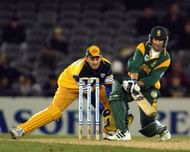
The curious case that arises with Jonty Rhodes was that he was such an impressive fielder that it often took our sight away from his batting exploits. He was renowned for guarding the off-side field single-handedly and for his superhuman dive to run out Inzamam-ul-Haq. Don't mistake him for a one-trick pony, though. Rhodes was a predatory fielder at backward point but also a very exciting batsman who could muscle balls out of the park.
Rhodes played a fair number of innings batting at number six or lower. His 98 in an ODI against Pakistan came after he had come out to bat at 86/4; South Africa eventually posted 272 on the board. On another occasion against Australia in 1997, Rhodes scored an unbeaten 83 while none of his teammates contributed over 25 runs in a partnership.
His career strike soared over 80 in ODIs while he averaged over 35. At number six, Rhodes' strike rate went up to 82.29 as he scored over 1700 runs at an average of 32.
Rhodes' power shots bludgeon balls over the boundaries would have been a treat in T20 cricket. And who would want to miss witnessing Jonty Rhodes fielding at backward point again?
#3: Michael Bevan
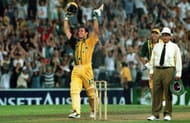
In an ODI against the West Indies, while chasing a modest total of 173, Australia would never have envisaged Curtley Ambrose's storm wrecking their top order. With the Australian innings reeling at 15-2 after Michael Slater's run out, Ambrose rubbed insult to injury by dislodging the stumps of Ricky Ponting on the very first ball the batsman faced.
Australia's batting order crumbled like a piece of cookie under the onslaught of the West Indies' quickies as they stumbled to 38-6 at one point. At the other end, however, Michael Bevan exercised patience and weathered the storm that others tried to ride. The left-hander eventually guided Australia to an unlikely one-wicket victory with a last-ball boundary.
That was one of the many innings Michael Bevan anchored and finished for Australia. Although he was not known for his pinch-hitting, Bevan was perfectly suited for the anchor role in the lower middle order, one who didn't budge under pressure and took the initiative at the right time. The left-hander could have played a similar role in T20 cricket too.
#2: Ajay Jadeja
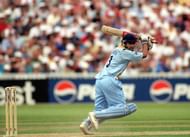
Waqar Younis charging in was a dreadful sight for any batsman in the 90's. In a 1996 World Cup game, with Younis having two overs of his quota left at the end of 47 overs, India's best-case score from 238/6 was expected to be somewhere around 260. But who could have predicted Waqar Younis being dispatched for 40 runs off his last two overs? With Ajay Jadeja at the crease, you could never count against any bowler disappearing for a few.
In that game, Jadeja cleared his front leg off an attempted toe-crushing yorker and flicked the ball straight over the mid-wicket boundary. Not to forget, Waqar Younis was a potent exponent of the yorker. The ostentatious 45 off 25 by Jadeja eventually thrust the Indian score to 287 off 50 overs.
Jadeja played many swaggering knocks of similar stature in ODIs. He scored a counter-attacking century against Australia at the Oval in 1999 after India were reduced to 17/4. His strike rate while batting in the lower middle order was more than 75 while he had a solid average of about 37.
The right-hander's ability to provide late flourishes to innings would have been more than handy in T20 cricket, the shortest format of the game.
#1: Lance Klusener
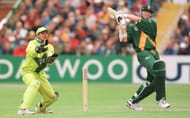
"We decided Lance as a team man can only cause hassles and we want to move forward in SA cricket."
Graeme Smith quoted this back in 2003 when he was newly appointed as the South African captain at just 22 years of age. That was in response to Lance Klusener being dropped for the England tour in the same year. Due to recurring ankle injuries and his regressing relations with the young Graeme Smith, Klusener's career ended in 2004, only eight years after his debut.
On his day, however, Lance Klusener was an MVP, a Ben Stokes-like persona who was equally good with bat and ball. He was the Man of the Tournament in the 1999 World Cup for his exploits with both bat and ball. The tournament, however, ended on a disappointing note for Klusener and South Africa as the left-hander's lone battle couldn't guide South Africa to the final despite taking his team to within one run of a victory.
Klusener was a hard-hitting batsman in ODIs who had a strike-rate of less than 80 only at number four, despite having played at every batting position except 11th. In the run-up to the 1999 World Cup, Klusener had made a string of excellent contributions with the bat where his strike rate constantly soared over 100.
Every cricket lover would surely have loved to see Klusener go berserk with the bat in T20 cricket, and there's no doubt that he would have been an asset for any side in the shortest format of the game.
Follow IPL Auction 2025 Live Updates, News & Biddings at Sportskeeda. Get the fastest updates on Mega-Auction and cricket news
